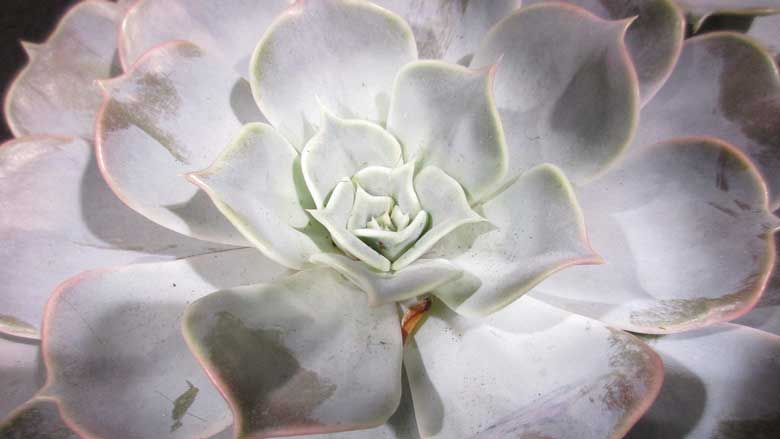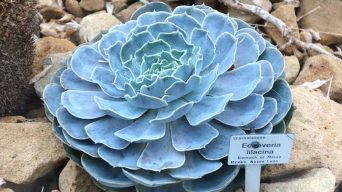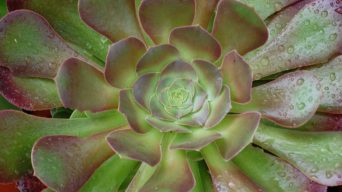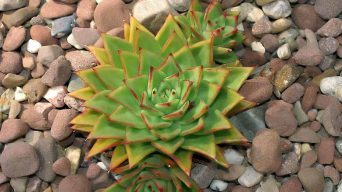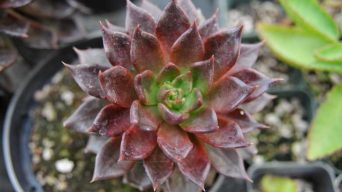Echeveria plants, also called hen and chicks, are very popular indoor houseplants.
They originate from Mexico and California. Most Echeveria species are easy to care for and propagate – even for people with a black thumb.
They can be used as a very rewarding houseplant that tends to survive and thrive with relatively little effort from the gardener.
Echeveria subsessilis is one Echeveria variety that is relatively easy to care for and propagate.
It has a unique growth pattern, which makes it highly desirable for indoor gardeners.
This article discusses the care requirements of Echeveria subsessilis and how you can propagate your own plant easily.
Overview
Echeveria subsessilis, commonly known as Morning Beauty Echeveria, is a small succulent from the Crassulaceae family that grows in Mexico’s mountains.
It’s thought to be a variant of Echeveria peacockii that had evolved, and it’s even listed in some catalogs as E. peacockii var Subsessillis.
It’s also been suggested that it’s a cross between Echeveria shaviana and Echeveria cante.
Echeveria subsessilis is a succulent plant with a single rosette of many densely packed leaves.
The Rosette of this small Echeveria may reach a diameter of 4 inches (10 cm).
The leaves are greenish-blue, softly keeled on the upper surface, and have long, tapering leaf tips and fine pink to red margins slightly curved.
The slender, erect stems bear numerous yellow-orange flowers that are arranged in clusters. They blossom in the spring.
How To Care for Echeveria Subsessilis ‘Morning Beauty’
Echeveria subsessilis care is relatively simple, and most people growing Echeveria succulents report minimal problems with their plants.
Below you’ll find the essential information you need to know about caring for Echeveria subsessilis ‘Morning Beauty’.
Sun Exposure & Light Requirements
Because of their tough nature, Echeveria subsessilis need full sun exposure to grow healthier with a hardier look.
In colder climates, you can place them in a partially shaded area for a little while to help them from getting scorched by the sun.
Be sure they receive at least 4 hours of full sunlight each day, as this will also give them the energy needed to produce those beautiful flowers.
Watering Requirements
Regarding watering, it is best to let the top inch or so of soil dry out before you water it again.
During the winter, this plant can handle a bit less frequent watering and not as deep of an application.
It will need more frequent watering during spring and summer; once every two weeks should do fine.
The one thing you want to avoid with this plant is overwatering it.
Water early enough in the day so that the soil has time to dry out from moisture before it gets cold. That way, you will reduce the chance of root rot.
Also, don’t let water sit in the rosette of leaves; this can cause rot and lead to the deterioration of the plant.
Soil Requirements
Echeveria subsessilis plants grow well in a succulent or cacti potting mix of coarse sand with some perlite.
This soil type is well-draining and porous, allowing plenty of aeration to the plant’s roots.
This is an important consideration, as Echeveria subsessilis are prone to root rot in poorly drained soil.
In addition to being well-draining, it’s also composed of ingredients that will retain water and slowly release it back to the plant.
Temperature and Humidity
The Echeveria subsessilis plant does best when it is kept at a specific temperature.
Temperatures that are too high or too low can have adverse effects on the succulent, including reduced growth rate and total plant failure.
The optimal temperature for Echeveria subsessilis ‘Morning Beauty’ is between 70-85 °F (21 – 29 °C).
If kept below that or above it, the succulent may not grow as well as it could.
An excellent way to help your plant keep the correct temperature is to keep it on a windowsill or other location where it can get sunlight.
The Echeveria subsessilis plant also requires particular levels of humidity to survive.
Too much water – whether from rain or misting – can cause the succulent to rot, while too little moisture can cause its leaves to turn brown.
A good way to measure the humidity of your growing area is by using a hygrometer – this will tell you exactly how much moisture is in the air.
The Echeveria subsessilis plant requires around 40% humidity levels to survive, so you must keep track of them.
Fertilizing
Echeveria subsessilis succulents don’t need fertilizers; they have a very slow-growing rate and adapt to dry conditions.
However, if you would like to fertilize them, use a balanced liquid fertilizer diluted to half-strength during the growing season (spring and summer).
Avoid fertilizing during the winter, as this can damage Echeveria plants.
Be careful not to overfertilize; too much fertilizer will kill your plants.
Potting and Repotting
When the rosettes of Echeveria subsessilis ‘Morning Beauty’ become too big for their pots, they will need to be repotted. This is important to do every two years or so.
The Morning Beauty Echeveria also likes to be slightly underpotted, so a pot one size up from the current pot would be ideal for this plant.
Ensure the Echeveria has enough room to spread out its roots.
When repotting, especially when starting with a larger pot, it is important not to damage or break any of the plant’s rosettes.
This can be done by making small cuts into the soil before putting new soil on top and gently guiding the roots away from any rosettes that could be damaged.
The best type of pots to use for Echeveria subsessilis ‘Morning Beauty’ are ones with a drainage hole in the bottom.
Terracotta and unglazed pots work well, as they can breathe and allow some air to get to the roots.
Pruning
Echeveria subsessilis plant doesn’t need pruning or pinching, and in fact, you should avoid it.
However, if your plant has dead leaves or flowers, cut them cleanly without touching the healthy leaves.
This will help avoid the spreading of diseases and pests.
The Echeveria subsessilis can grow a bit untidy – meaning that it may spread to a larger size than intended, but it will keep its great variegated look.
This means you don’t need to prune your plant even if you have a smaller potted plant.
Pests and Diseases
When it comes to pests and diseases, Echeveria Subsessilis ‘Morning Beauty’ is very resilient.
However, it might be affected by the common pests and diseases that other succulents are also prey to.
Mealybugs
Mealybugs are the most common pests that affect succulents, including Echeveria Subsessilis ‘Morning Beauty’.
This pest is usually described as a tiny, white insect that has the appearance of cotton.
They cause damage to plants by sucking out their juices and leading them to death.
Use a cotton swab dipped in rubbing alcohol to control them and dab it on the affected area.
Aphids
Aphids are also very common pests, especially in humid weather conditions. They are usually tiny and greenish.
They can affect Echeveria Subsessilis ‘Morning Beauty’ by sucking the sap from its leaves and flowers, which causes the yellowing of the plant or a reduction in the size of its flowers or leaves.
However, they are easily controlled if you spray the affected area with neem oil or insecticidal soap.
You can also clean them off by dabbing some rubbing alcohol on a cotton swab.
Scales
Scales are insects that usually appear as tiny bumps and have a waxy coat to protect their body from predators.
They use these protuberances as an advantage because they feed on sap by sucking it.
They do this by inserting their mouthpiece, which can penetrate even the toughest leaves, into the plant’s tissues; therefore, scales are challenging to control.
The most effective way to remove them is by spraying neem oil or insecticidal soap onto the affected area.
Root Rot
Echeveria Subsessilis ‘Morning Beauty’ is highly susceptible to root rot.
When the plant’s roots are exposed to overly wet conditions, they begin to rot.
This can be avoided by ensuring that the soil dries out between waterings.
However, if the reason why the roots are exposed to wetness is that water cannot drain out of the container that Echeveria Subsessilis ‘Morning Beauty’ is planted on, then you need to repot it in a drainage pot.
Powdery Mildew
Powdery mildew is an airborne fungus that spreads easily between succulents, especially in warm and humid areas.
It can affect Echeveria Subsessilis ‘Morning Beauty’ by forming a powder on its leaves, making the plant look white or grayish.
To control this type of fungus, ensure that the area with Echeveria Subsessilis ‘Morning Beauty’ is adequately ventilated, and water it only when the topsoil of its container is dry.
Sunburn
Although Echeveria Subsessilis ‘Morning Beauty’ can tolerate very high temperatures, it cannot withstand direct sunlight without any protection.
If you place it under direct sunlight, its leaves might burn and turn red or even brown.
To prevent this from happening, make sure that your Echeveria Subsessilis ‘Morning Beauty’ is not exposed to direct sunlight during hot days, or move it at least a few meters away from the window of the room where it is located in.
How to Care for Echeveria Subsessilis ‘Morning Beauty’ in Winter
Echeveria subsessilis ‘Morning Beauty’ is a slow-growing, usually solitary plant.
During the winter months, it can be kept indoors with a minimum temperature of 15°C (59°F).
Move the Echeveria outdoors in summer to benefit from increased light levels and consistent temperatures.
In winter, you’ll need to provide slightly less water but keep the soil moist all the time. Generally, this plant does well when left dry in winter.
As for sunlight exposure, Echeveria subsessilis ‘Morning Beauty’ thrives under bright light.
The best location for this succulent is in direct sunlight all day long.
How To Propagate Echeveria Subsessilis ‘Morning Beauty’
Echeveria subsessilis, the Morning Beauty Echeveria, can be easily propagated by leaf cuttings and offsets.
##Propagating The Echeveria Subsessilis ‘Morning Beauty’ from Leaf Cuttings
To propagate the Morning Beauty Echeveria, you can use leaf cuttings.
- Remove a healthy, young succulent leaf from your Morning Beauty Echeveria with a sharp knife. Make sure to leave a small portion of the leaf above the level of the rosette.
- Let the leaf cutting dry out and ‘callous’ for about two days.
- Pot up the cutting in a porous cactus and succulent soil mix. Water it well, but let the soil dry out completely before watering again.
- Keep it in a bright location and wait for new growth! The leaf should root itself and sprout tiny plantlets. Once these emerge from the soil, they can be transplanted into their own pots.
Propagating The Echeveria Subsessilis ‘Morning Beauty’ from Offsets
To propagate your Morning Beauty Echeveria, you can use offsets. Offsets are small plants that grow off the main plant.
To propagate your plant using offsets, wait for the offset to grow at least two leaves.
- Use a sharp knife or shear to cut off the offset from the mother plant. Make sure you leave enough of the stem intact so that it will be able to root itself.
- Pot up each offset in a small pot filled with porous cactus and succulent soil mix. Water well, but make sure the soil is completely dry before you water again.
- Keep your offsets in a bright location and protect them from direct sunlight.
- The offsets should start to root themselves in around 3-4 weeks. Once they have established roots, water them as you would the parent plant.
Final Thoughts
The Morning Beauty Echeveria is definitely a species to add to your collection for a plant that is so easy to grow and propagate.
Echeveria subsessilis care is quite easy and problem-free once you know what you’re doing.
The most important part of the care is to make sure that they get plenty of sunlight.
They also require a very well-draining soil, so if you know your soil is not draining well, it would be best to choose another plant.
Finally, the Echeveria subsessilis has a very shallow root system, so using a succulent potting mix rather than regular potting soil would be best.

